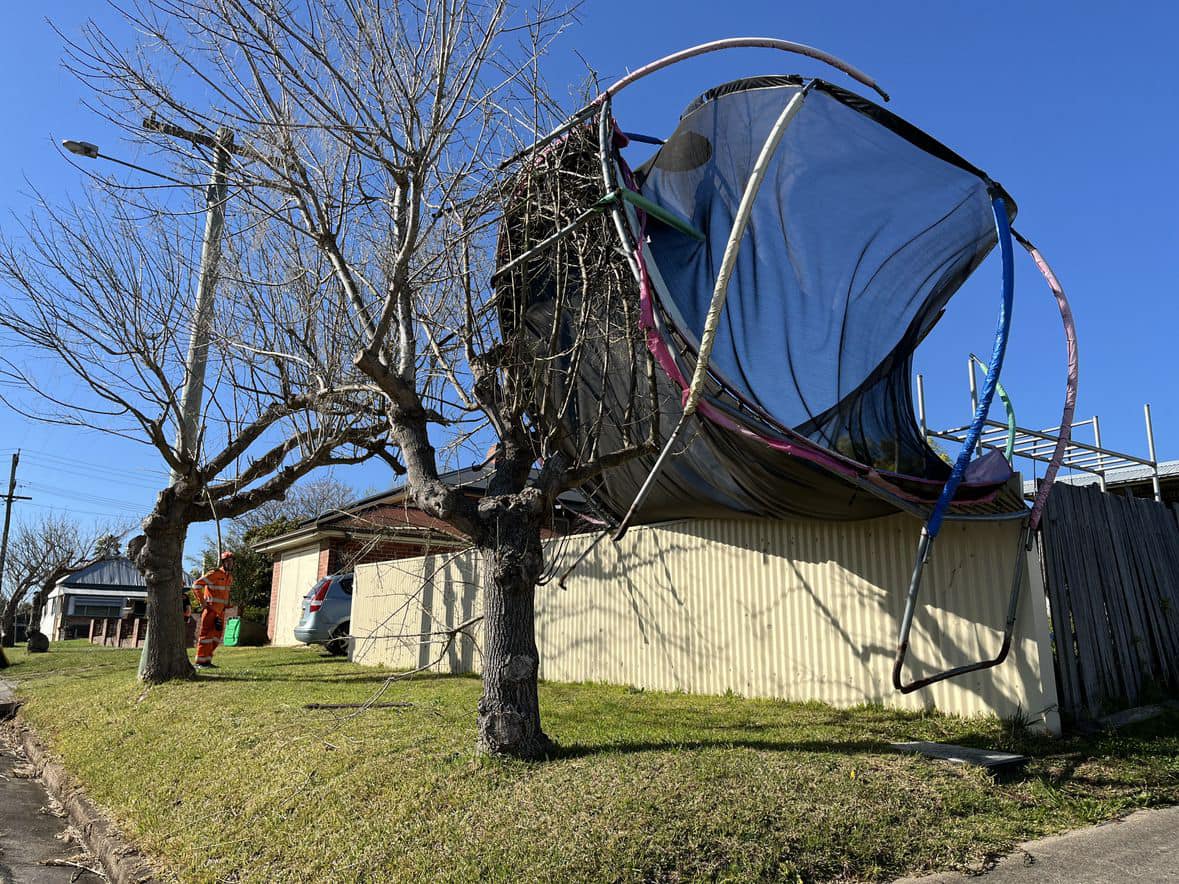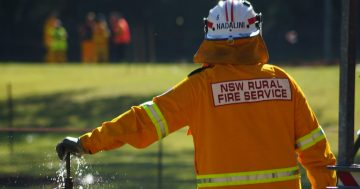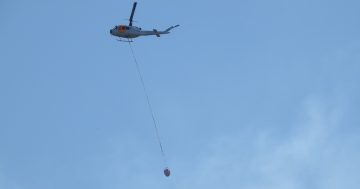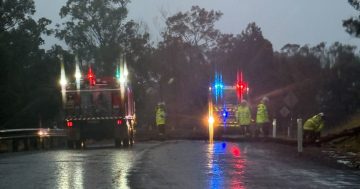
A trampoline was thrown into the air in Bega during Wednesday’s winds. Photo: NSW SES.
Brutal winds resulted in damage along the NSW Far South Coast this week, but unfortunately it is looking like another round is expected over the coming days.
Significantly, the winds reignited numerous pile burns in the Bega Valley and Eurobodalla, although the quick actions of firies prevented these from causing any real harm.
On Wednesday (28 August), winds peaked at 67 km/h with gusts of 82 km/h at Green Cape, which is south of Eden, and at 41 km/h with gusts of 61 km/h in Moruya, according to Weatherzone.
The NSW Rural Fire Service’s (RFS) district coordinator for the Far South Coast, Chris Anderson, said his crews saw a number of pile burns reignite over the Bega Valley and the Eurobodalla on Wednesday.
“Some amazing work by RFS crews kept the fires very small and there was no damage done to anything,” he said.
He thought a lot of these pile burns were lit weeks ago and they had reignited due to the excessive winds, describing Wednesday’s conditions as “horrendous”.
He also didn’t think it was surprising that the piles had restarted, due to the lack of rain recently and given the speed of the winds.
In addition to these fires, Mr Anderson said his crews were “kept very busy” on Wednesday, working from 3 am to 9 pm.
RFS crews attended 31 incidents across the Far South Coast, with many jobs involving trees that had fallen across roads.

Eurobodalla Shire Council fielded a number of calls about trees across its roads on Wednesday (28 August). Photo: ESC.
Meanwhile, NSW State Emergency Service (SES) members responded to 71 incidents in the Eurobodalla and Bega Valley over Wednesday, mostly for fallen trees and roof-related damage.
Members assisted when a roof was blown off a building at Catalina and three pine trees fell on a house at Tomakin.
“NSW SES volunteers will be back in the field today assisting in the cleanup,” an SES spokesperson said on Thursday (29 August).
A Eurobodalla Shire Council spokesperson said Wednesday’s strong winds had a significant impact on their roads, with more than 70 fallen trees cleared since crews started work at 4 am.
“Early work focused on cutting and pushing fallen trees, ensuring roads are safe to use. Now we are working to clear the remaining debris,” they said.
“This will take some time and we urge road users to drive to road conditions and report any fallen trees to council.”
The Bureau of Meteorology said a severe weather warning for damaging winds remained in place for parts of the South Coast, Snowy Mountains, Southern Tablelands and the ACT until Friday (30 August).
But according to Weatherzone, the region’s windy conditions are likely to continue into next week, with 45 km/h winds at Green Cape and 32 km/h winds at Moruya expected on Monday.
Given the number of pile burns that reignited yesterday, Mr Anderson urged everyone to check on any burning they had done in the past month.
“Yesterday, the wind may have reignited the burns and they could be sitting there, smouldering,” he said.
He also reminded residents that the bushfire danger period begins on Sunday (1 September), which means everyone will need a permit to conduct burns at their properties – although these are easily obtained through the RFS’s website.
“Now is the time that people should start thinking about what they are going to do with their bushfire survival plans,” Mr Anderson said.
The RFS is holding its Get Ready Weekend in September and residents can check its website to find the closest event to them.
Mr Anderson said the recent conditions on the Far South Coast were warmer than average, while the winds meant the region was drying out quickly.
“What that looks like in the months ahead is still unknown, but we are looking at a normal bushfire season as we head into summer,” he said.

The Brogo Rural Fire Brigade was called when a tree fell on power lines on Wednesday (28 August). Photo: Brogo Rural Fire Brigade Facebook.
NSW SES Deputy State Duty Commander, Chief Superintendent Dallas Burnes, strongly advised people to remain indoors and away from trees and powerlines during strong winds.
“People should safely secure any loose items around their properties, if they haven’t already, so they don’t become projectiles in this damaging wind,” he said on Wednesday.
“We’ve already been called to secure trampolines that have blown onto roads and footpaths.”
For people in the regions affected by winds, the SES says:
- Move vehicles under cover or away from trees
- Secure or put away loose items around your house, yard and balcony
- Keep at least eight metres away from fallen power lines or objects that may be energised, such as fences
- Trees that have been damaged by fire are likely to be more unstable and more likely to fall
- Report fallen power lines to either Ausgrid (131 388), Endeavour Energy (131 003), Essential Energy (132 080) or Evoenergy (131 093) as shown on your power bill
- Stay vigilant and monitor conditions. Note that the landscape may have changed following bushfires
- For emergency help in floods and storms, ring your local SES Unit on 132 500.
















